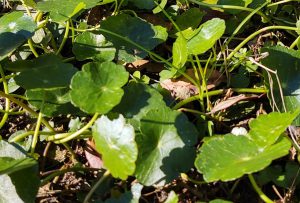How to recognize it:
Dollarweed is a moisture-loving plant that can be hard to manage in lawns and landscape beds. Also know as pennywort, Dollarweed (Hydrocotyle spp.), is a warm-season perennial weed. It is named because of its silver-dollar-shaped leaves. Some say, it is because we spend so much money to grow it by overfertilizing and overwatering our lawns. They are round with a scalloped edge. They are easy to spot due to the bright green, fleshy leaves sticking up in the air. Joey Williams, Extension Agent from Clemson described them as miniature lily pads measuring 1-2″ in diameter.

An indicator of soil conditions:
The presence of Dollarweed indicates that there is excessive moisture in the area. Low lying areas or soils with hard clay pan that drain slowly are ideal conditions for Dollarweed. Around ponds or lakes where levels fluctuate is another area to find it. Dollarweed can even float on water. In well drained sandy soils, overirrigation is generally the problem. Research at the University of Florida demonstrated a reduction in Dollarweed by just reducing irrigation frequency. https://edis.ifas.ufl.edu/ep389.
Hand removal:
It is a low-growing habit that spreads readily by rhizomes, seeds and tubers. If you try to hand remove Dollarweed, you must get the fleshy white rhizomes and tubers or it will grow back quickly. A horticultural game that I play is to see what the longest rhizome is I can pull up on a given plant. My record so far is 5’3″.
Chemical control:
Choose a herbicide according to the kind of lawn grass you have. A mix of pre- and post- emergent herbicide is most effective. Pre-emergent herbicides should be applied in early spring BEFORE weeds emerge. Post emergent herbicides should be applied in late spring (after full soring green-up of the lawn) when weeds are small. Herbicide work best on small weeds and become less effective as the plant matures. A helpful link for specific chemicals is https://hgic.clemson.edu/factsheet/dollarweed/.
Keep in mind that total eradication of weeds in your yard is unpractical unless you spend every waking moment combatting them. It is more feasible to control them to tolerable levels. Keep your lawn healthy by mowing high as it can help shade out unwanted weeds, fertilize as needed (soil test) and irrigate only when the grass starts to wilt. Also a few weeds provides biodiversity and will help native pollinators and other insects.
 3
3
